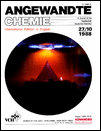Cover Picture (Angew. Chem. Int. Ed. Engl. 10/1988)
Graphical Abstract
The title picture shows the luminescence of a Ni(CO)4 molecular beam after excitation with a xenon chloride UV laser. The pulsed molecular beam emerges from a nozzle (above in the picture, diameter ca. 50 μm) and expands conically. Interaction with the laser pulse leads to photolysis and formation of excited Ni(CO)3, which is responsible for the luminescence. In the center of the picture is the cone of a skimmer, the function of which is to admit only the core of the molecular beam through an opening (diameter < 1 mm) and thus collimate the beam. Such molecular beam experiments make it possible to investigate the physical-chemical basis of laser-activated gas-phase deposition of solids. Further, high-purity nickel films can be deposited on substrates in this way. More details on gas-phase deposition of thin metal and semiconductor films, as well as on high-quality powders for ceramics and on etching reactions for surface microstructuring, are reported by K. L. Kompa in a review article on p. 1314ff.





